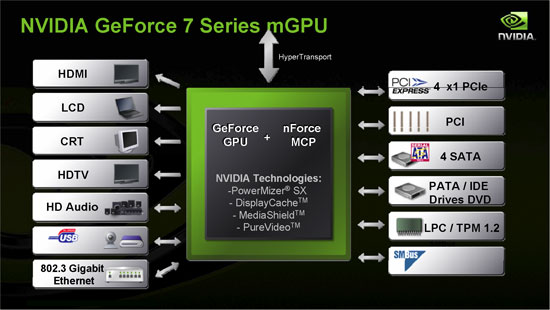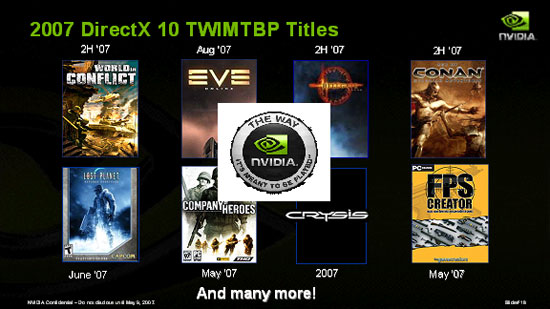NVIDIA GeForce 8M: DirectX 10 Goes Mobile
by Jarred Walton on May 9, 2007 1:00 PM EST- Posted in
- GPUs
Additional Notebook Solutions
The new GeForce 8M hardware isn't the only mobile product being launched today by an NVIDIA. They are also releasing some new integrated graphics chipsets as well as business and workstation solutions. Following is a table of all of the products being launched today.
We won't dwell much on the business and workstation products. The business solutions are based off the same GeForce 8M GPUs, with the primary difference being an effort to ensure better reliability, stability, and compatibility. For IT departments, that usually means that the manufacturers spend extra time testing and qualifying the hardware and drivers before releasing them to the public. The new chipset solutions deserve a bit more attention.
What Is a Motherboard GPU (mGPU)?
NVIDIA calls the new chipsets "Motherboard GPUs" and defines that as the following:

Put another way, it sounds like NVIDIA's latest IGP solutions now come with better performance and a few new features. These new IGP chipsets don't support DirectX 10, but they do support Shader Model 3.0 and they apparently also include the new VP2 hardware to handle H.264 decoding. They are supposed to be up to 40% faster than the last generation IGPs while consuming less power in order to increase battery life.
Better performance sounds nice in theory, but 40% faster than "really slow" still ends up being really slow, sort of like any number multiplied by zero ends up being zero. For gaming, we seriously doubt any of the new IGP solutions will offer acceptable performance -- even some of the midrange GPUs struggle after all -- but the inclusion of video processing engine and HDCP support is still a plus.
Another slide in the presentation states that these new mGPUs offer the "longest battery life for Turion class UMA notebooks." Unfortunately, we take that to mean that for the time being these new chipsets are for AMD platforms and not for Core 2 Duo, although that wasn't entirely clear.
Closing Thoughts
There's plenty of marketing hype in any new product launch, but while these latest NVIDIA products may not rid the world of hunger or ensure the continued survival of mankind, they do appear to offer some interesting benefits. Notebooks are undoubtedly becoming more and more popular, but anyone who has an interest in gaming has likely discovered that getting a laptop capable of keeping up with even a $1000 desktop in the latest games becomes a very expensive proposition. This latest product launch is just one more step towards improving mobile graphics performance.

The smaller size and added engineering costs are sure to keep entrance fees for the mobile market higher than what you would expect to pay for equivalent performance on the desktop, but at the very least we should now have a few more options when it comes time to purchase a new notebook. Now all we need is more applications that can truly benefit from this next generation hardware, and thankfully we should get at least several DirectX 10 games by the end of this year.
The new GeForce 8M hardware isn't the only mobile product being launched today by an NVIDIA. They are also releasing some new integrated graphics chipsets as well as business and workstation solutions. Following is a table of all of the products being launched today.
| NVIDIA Notebook Products Launching Today | |||
| Segment | Consumer | Business | Workstation |
| Enthusiast | |||
| Performance | GeForce 8600M GT GeForce 8600M GS |
Quadro NVS 320M | Quadro FX 1600M |
| Mainstream | GeForce 8400M GT GeForce 8400M GS GeForce 8400M G |
Quadro NVS 140M Quadro NVS 135M Quadro NVS 130M |
Quadro FX 570M Quadro FX 360M |
| Value | GeForce 7190M + nForce 650M GeForce 7150M + nForce 630M GeForce 7000M + nForce 610M |
||
We won't dwell much on the business and workstation products. The business solutions are based off the same GeForce 8M GPUs, with the primary difference being an effort to ensure better reliability, stability, and compatibility. For IT departments, that usually means that the manufacturers spend extra time testing and qualifying the hardware and drivers before releasing them to the public. The new chipset solutions deserve a bit more attention.
What Is a Motherboard GPU (mGPU)?
NVIDIA calls the new chipsets "Motherboard GPUs" and defines that as the following:
- Combines a true GPU with motherboard core logic
- Support for DirectX 9.0 Shader Model 2.0 or higher
- At least one digital connector (DVI/HDMI) with HDCP support
- Multi-display support
- A dedicated video processing engine for HD video

Put another way, it sounds like NVIDIA's latest IGP solutions now come with better performance and a few new features. These new IGP chipsets don't support DirectX 10, but they do support Shader Model 3.0 and they apparently also include the new VP2 hardware to handle H.264 decoding. They are supposed to be up to 40% faster than the last generation IGPs while consuming less power in order to increase battery life.
Better performance sounds nice in theory, but 40% faster than "really slow" still ends up being really slow, sort of like any number multiplied by zero ends up being zero. For gaming, we seriously doubt any of the new IGP solutions will offer acceptable performance -- even some of the midrange GPUs struggle after all -- but the inclusion of video processing engine and HDCP support is still a plus.
Another slide in the presentation states that these new mGPUs offer the "longest battery life for Turion class UMA notebooks." Unfortunately, we take that to mean that for the time being these new chipsets are for AMD platforms and not for Core 2 Duo, although that wasn't entirely clear.
Closing Thoughts
There's plenty of marketing hype in any new product launch, but while these latest NVIDIA products may not rid the world of hunger or ensure the continued survival of mankind, they do appear to offer some interesting benefits. Notebooks are undoubtedly becoming more and more popular, but anyone who has an interest in gaming has likely discovered that getting a laptop capable of keeping up with even a $1000 desktop in the latest games becomes a very expensive proposition. This latest product launch is just one more step towards improving mobile graphics performance.

The smaller size and added engineering costs are sure to keep entrance fees for the mobile market higher than what you would expect to pay for equivalent performance on the desktop, but at the very least we should now have a few more options when it comes time to purchase a new notebook. Now all we need is more applications that can truly benefit from this next generation hardware, and thankfully we should get at least several DirectX 10 games by the end of this year.










18 Comments
View All Comments
Scipio Africanus - Sunday, June 24, 2007 - link
Not to nitpick, but the introduction comment about nvidia dominating ati at the midlevel is not right. The 7600 and X1600 Mobility were competitive with each other. The mobile version of the 7600 had only 8 pipelines, instead of the desktop version's 12. Consequently, depending on the game, one was faster than the other or vice versa. This was extensively benchmarked on notebookreview forums.JarredWalton - Friday, August 31, 2007 - link
All I know is I have an Mobile X1700 and a Go 7700. The latter spanks the heck out of the former. (That would be the ASUS A8Js vs. the ASUS G2P.)ChrisLilley - Thursday, May 10, 2007 - link
I think the workstation column is wrong. For series 7, the workstation lineup is 350M (low end), 1500M (midrasnge) and 2500M, 3500M (high end, 3500m is an overclocked 2500M) as follows:NVIDIA_G71.DEV_0298.1 = "NNVIDIA GeForce Go 7900 GS"
NVIDIA_G71.DEV_0299.1 = "NNVIDIA GeForce Go 7900 GTX"
NVIDIA_G71.DEV_029A.1 = "NNVIDIA Quadro FX 2500M"
NVIDIA_G71.DEV_029B.1 = "NNVIDIA Quadro FX 1500M"
NVIDIA_G72.DEV_01D8.1 = "NNVIDIA GeForce Go 7400"
NVIDIA_G72.DEV_01DA.1 = "NNVIDIA Quadro NVS 110M"
NVIDIA_G72.DEV_01DC.1 = "NNVIDIA Quadro FX 350M"
The known released GPU IDs for 8xxxM are as follows
NVIDIA_G84.DEV_0407.1 = "NVIDIA GeForce 8600M GT"
NVIDIA_G84.DEV_0409.1 = "NVIDIA GeForce 8800M GS"
NVIDIA_G84.DEV_040D.1 = "NVIDIA Quadro FX 1600M"
NVIDIA_G86.DEV_0425.1 = "NNVIDIA GeForce 8600M GS"
NVIDIA_G86.DEV_0427.1 = "NNVIDIA GeForce 8400M GS"
NVIDIA_G86.DEV_0428.1 = "NNVIDIA GeForce 8400M G"
NVIDIA_G86.DEV_0429.1 = "NVIDIA Quadro NVS 140M"
NVIDIA_G86.DEV_042B.1 = "NVIDIA Quadro NVS 135M"
NVIDIA_G86.DEV_042D.1 = "NVIDIA Quadro FX 360M"
That makes the 1600M a replacement for the 1500m, based on 8600GS and midrange ('performance'). The 5700 should be under 'mainstream'. The enthusiast or perhaps 'heavy cad' cards - the replacements for the 2500M and 3500M - are, just like the enthusiast gaming cards, not released and likely waiting for a die shrink.
JarredWalton - Thursday, May 10, 2007 - link
I'm going by the classification NVIDIA gave the various cards on one of the slides. Note that existing products are not included in the tables, only the new stuff, so outside of the mGPU parts (business) all of the cards are presumably DX10 capable. I would expect that the "enthusiast" 1600M is no faster than the other 8M parts listed, but there were no details on clock speeds or features of the workstation chips. I'm not sure any of the workstation parts listed are even shipping yet; most likely they are only being announced right now pending actual use in notebooks. I can check with NVIDIA for more details on those parts, though....JarredWalton - Thursday, May 10, 2007 - link
http://www.nvidia.com/object/IO_42274.html">More details on mobile Quadro cards are available here. Basically, they are all DX10 parts, and the 1600M will probably be similar to the 8600M GT. Possibly it will be tuned such that the performance offered in workstation apps will be worthy of inclusion in the "enthusiast" range, although I'd say "workstation enthusiast" is a bit of an oxymoron. :)ChrisLilley - Saturday, May 12, 2007 - link
Thanks for the link. And yes, its the same for mobile workstation cards as for mobile gaming cards: the top performing ones ('enthusiast' or 'serious cad user' or just lets say 'expensive' :) ) have not been announced yet as the hole in the model numbers shows. They will likely need a die shrink to get the heat down for mobile use. So the 7xxx series still hold top place for mobile.Plus of course the workstation models will be released a little after the gaming ones, due to the need for ISV certification.
Myrandex - Thursday, May 10, 2007 - link
I believe Duke Nuken Forever should have been on that list :)JarredWalton - Thursday, May 10, 2007 - link
Oh, it will be DX10, but that's a "most anticipated game for 2010". LOL(I actually have no idea when it's coming out or if it will be DX10.)
Thatguy97 - Friday, June 26, 2015 - link
lolbearxor - Thursday, May 10, 2007 - link
Any inkling or hints from nVidia that Apple might have picked a 8 series chip for the inevitable MBP refresh next month?